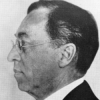Wassily Kandinsky

Wassily Kandinsky
Wassily Wassilyevich Kandinskywas an influential Russian painter and art theorist. He is credited with painting one of the first purely abstract works. Born in Moscow, Kandinsky spent his childhood in Odessa, where he graduated at Grekov Odessa Art school. He enrolled at the University of Moscow, studying law and economics. Successful in his profession—he was offered a professorshipat the University of Dorpat—Kandinsky began painting studiesat the age of 30...
NationalityRussian
ProfessionPainter
Date of Birth16 December 1866
CityMoscow, Russia
CountryRussian Federation
The work of art is born of the artist in a mysterious and secret way. From him it gains life and being. Nor is its existence casual and inconsequent, but it has a definite and purposeful strength, alike in its material and spiritual life.
Objects damage pictures.
It should not be forgotten that art is not a science where the latest 'correct' theory declares the old to be false and erases it.
Our epoch is a time of tragic collision between matter and spirit and of the downfall of the purely material world view.
Efforts to revive the art principles of the past at best produce works of art that resemble a stillborn child.
In your works, you have realized what I, albeit in uncertain form, have so greatly longed for in music. The independent progress through their own destinies, the independent life of the individual voices in your compositions is exactly what I am trying to find in my paintings.
The artist must be blind to distinction between 'recognized' or 'unrecognized' conventions of form, deaf to the transitory teaching and demands of his particular age.
There is, however, in art another kind of external similarity which is founded on a fundamental truth. When there is a similarity of inner tendency in the whole moral and spiritual atmosphere, a similarity of ideals, at first closely pursued but later lost to sight, a similarity in the inner feeling of any one period to that of another, the logical result will be a revival of the external forms which served to express those inner feelings in an earlier age.
With cold eyes and indifferent mind the spectators regard the work. Connoissers admire the "skill" (as one admires a tightrope walker), enjoy the "quality of painting" (as one enjoys a pasty). But hungry souls go hungry away. The vulgar herd stroll through the rooms and pronounce the pictures "nice" or "splendid." Those who could speak have said nothing, those who could hear have heard nothing.
Every work of art is the child of its age and, in many cases, the mother of our emotions. It follows that each period of culture produces an art of its own which can never be repeated.
Generally speaking, color directly influences the soul.
The sound of colors is so definite that it would be hard to find anyone who would express bright yellow with bass notes or dark lake with treble...
The force that propels the human spirit on the clear way forward and upward is the abstract spirit.
The artist must train not only his eye but also his soul, so that it can weigh colours in its own scale and thus become a determinant in artistic creation.